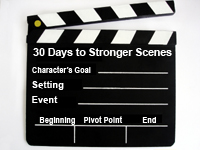Featured Today in Fiction Notes Store
Selecting the Right Scenes: Most Dramatic Way to Tell a Story

30 Days to a Stronger Scene Table of Contents
Jumping Between Scenes
After you’ve decided on the scene you want to zoom into for details, you might want to stop and ask yourself, if you can omit some of those scenes.
Scene cuts allow you to omit even more scenes by cutting out the transitions, letting the readers assume some things and getting on with the action.
Watch CSI, the TV series about crime investigations. They often find a clue that leads them to Suspect X. They do not show getting a search warrant (as a lawyer show might do), executing the search warrant (as a cop show might do), or arresting Suspect X (as a cop show might do). Instead, they focused on clues and investigating crimes. There’s a scene cut from finding the clue to Suspect X sitting in a room waiting to be questioned so the next clue can be revealed.
In other words, part of the clue (sorry!) to scene cuts is what is your focus. Leave out whatever doesn’t relate to the focus and theme of your story.
You do, however, want to make sure there’s some connection between scenes and that you don’t have to discuss it in detail. You want to jump from one scene to the next quickly, to maintain the pace; don’t get bogged down in explanations. So, you’ll look for ways to connect the scenes. In the CSI example, it’s connected because Suspect X is mentioned in the first scene and produced in the second.
Look for other ways to connect scenes: Character, setting, dialogue, timelines, etc. Be creative, but make sure the reader understands where they are in the story and don’t become confused.

I had to play catch up here today, but it’s so worth it. I’m learning a lot from your posts. Your example from CSI is so good. I’m still learning how to decide what parts of the story, like the getting of the search warrant example, are unnecessary. I think it’s a common new writer (me) mistake to put too many of those unnecessary scenes in.
Thanks for reading! It’s not just new writers, we all do it. It’s all in the revisions!
Darcy